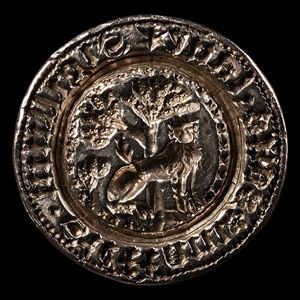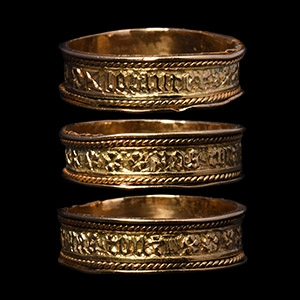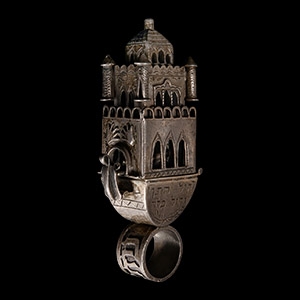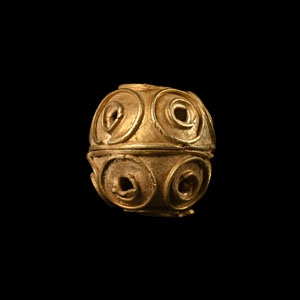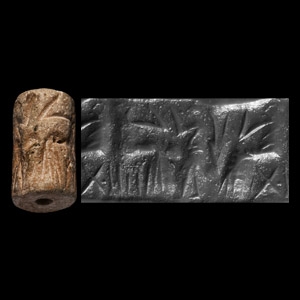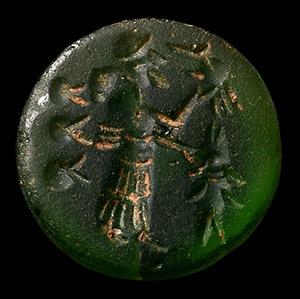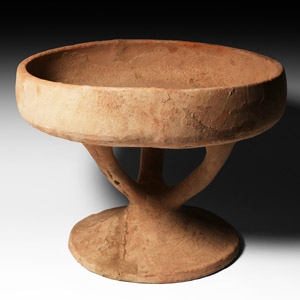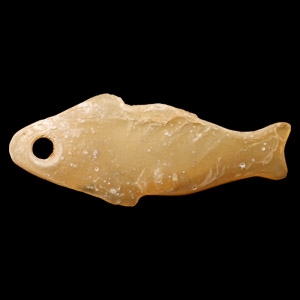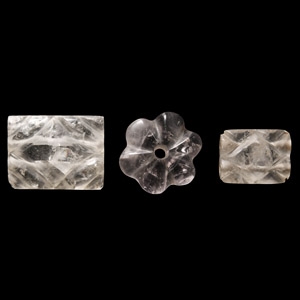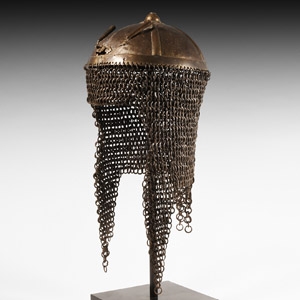A ceramic vessel with rounded underside, biconvex body, trumpet-shaped mouth with raised internal rim; spout to the shoulder; painted band of decoration to the shoulder. 724 grams, 21 cm wide
Acquired 1980-2015.
Ex Abelita family collection.
An architectural silver wedding ring composed of a rectangular-section hoop bearing the words ‘mazel tov’ (good fortune) in Hebrew characters; roughly cushion-shaped bezel with large openwork building above, likely representing Solomon’s temple or a synagogue, hinge and clasp at the base, opening to a model of what is likely a representation of the marriage contract which lifts out of its setting to reveal a void; incised stylised detailing to the building with two handprints placed over the arched doorway; Hebrew text to both principal faces of the bezel with wreaths below reading 'קול חתן וקול כלה' to one side and 'קול ששון וקול שמחה' to the other, together forming a quotation from Jeremiah 33:10-11: 'The voice of joy and the voice of gladness, the voice of the bridegroom and the voice of the bride'. 107 grams, 10.4 cm overall, 19.08 mm internal diameter (approximate size British S, USA 9, Europe 20, Japan 19)
From a UK private collection.
A Jewish wedding consists of the signing of a marriage contract (ketubah) and the gift of a token, usually a ring. The ring was generally worn only during the ceremony and is often made in the form of a miniature building, signifying the new household as well as the Temple in Jerusalem. Traditionally, the ring had to belong to the groom and to be made of a precious metal not set with any gemstones.
The Earliest Jewish wedding rings were found in the medieval treasure hoards of Erfurt in Germany and Colmar in France. The description of a wedding in 1400 by Rabbi Jakob hal Lewi Mölln (or Mishagin) made the importance of the ring clear: 'After the blessing, the Rabbi called two witnesses. He showed them the wedding ring and made them bear witness that it was worth at least a heller. Then he enjoined them to make sure that the groom fulfilled his marriage vow by saying the words 'By this ring let thou be given to me by the laws of Moses and of Israel'. He then put the ring on the bride's finger next to the thumb.'
An ovoid gold bead with filigree gold wire to the equator, five piercings to each hemisphere, each enclosed by concentric gold wire circlets, repeated at both terminals; hollow-formed. 0.82 grams, 10 mm
Acquired 1969-1999.
London collection of the late Mr S.M., thence by descent.
A mixed group of ceramic vessels including bowls, jars and cups, including examples painted with geometric motifs. 2.5 kg total, 7.9-15 cm
Acquired 1980-2015.
Ex Abelita family collection.
A copper zoomorphic bracelet with round-section penannular hoop, terminals formed as opposed animal heads, possibly rams with curled horns, with remains of facial detailing. 33.5 grams, 71 mm
Acquired before the early 1970s.
Ex London, UK, gallery.
Property of a London gentleman.
A chalk cylinder seal with frieze; accompanied by an old scholarly note, handwritten and signed by W.G. Lambert, late Professor of Assyriology, University of Birmingham, 1970-1993, which states: 'Cylinder seal of white stone, 28x17 mm. Two facing seated drinkers, wearing long robes and holding up cups. Standing servant in short clothes between them. Vessel with pointed base and two straws in it. Mesopotamian, c.2600-2400 B.C.. Top of seal damaged, but design deep and clear.' In a different hand beneath 'Sumerian seal; early Dynastic Period III. Banquet scene. Manuscript of Prof. W.G. Lambert' and further notation to the reverse; accompanied by a museum-quality impression. 7.2 grams, 28 mmFine condition.
From the private collection of Emilio Bacarani, Valbonne, France, 1950-1988.
Acquired in 1988.
From the collection of G.M.R.H., London, UK.
Accompanied by an original handwritten unsigned scholarly note by Professor Wilfrid George Lambert FBA.
A green glass stamp seal pierced through the handle for suspension, circular matrix with incuse Master of Animals figure standing right, a bird perched on one hand, other animals surrounding him in the field. 8.5 grams, 21 mm highFine condition.
Acquired 1969-1979.
London collection of the late Mr S.M., thence by descent.
A large terracotta chalice comprising a broad shallow bowl supported by three short arms on a conical base. 1.8 kg, 26.5 cm wide
Acquired 1980-2015.
Ex Abelita family collection.
A bulbous ceramic vessel with trumpet-style neck and rim, bichrome decorative design incorporating plain circumferential bands of varying width, with concentric roundels to the equator, repaired. 366 grams, 15.2 cm high
Acquired 1990s.
English private collection.
Property of an Essex gentleman.
A mother of pearl fish amulet, pierced eye also serving as a suspension loop. 0.87 grams, 28 mm
Acquired 1969-1999.
London collection of the late Mr S.M., thence by descent.
A trio of large rock crystal beads: two similar pillow-shaped beads with a lozenge to both faces, drilled twice for suspension; a stylised flower head with central hole for suspension. 68 grams total, 30-42 mm
Acquired in the 1980s.
From the collection of a West London, UK, gentleman.
A steel helmet comprising a domed cap and mail curtain; the cap with five radiating applied ribs from the central bronze rosette with hollow bulb finial, applied brow-band, pair of applied plume-holders and bracket for a falling nasal guard; curtain of substantial (1.83-195mm thick) rings forming a mail curtain with triangular extensions flanking the face and protecting the rear of the neck. 1.6 kg, 40 cm highSome damage to the rear including cracking and deformation, probably due to battle damage.
UK private collection before 2000.
UK art market.
Property of a London gentleman.
The plume-holders are placed beside two pairs of holes, possibly replacing a previous pair which were removed. Attachment of the mail to the browband is by means of smaller rings which are placed intermittently round the lower edge (or possibly some rings have been lost due to wear-and-tear).


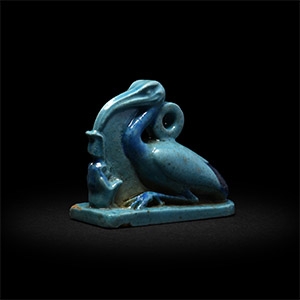



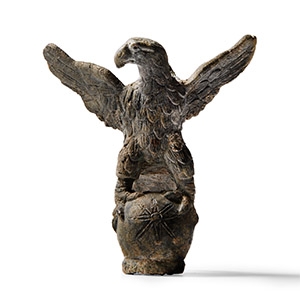
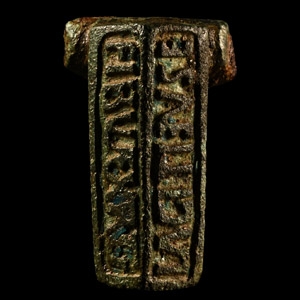

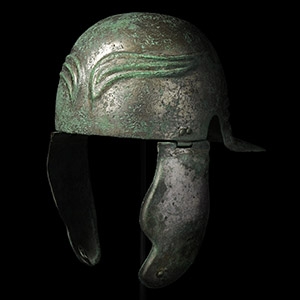
.jpg)
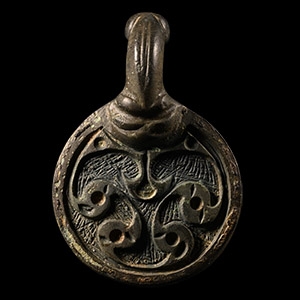
.jpg)
